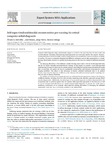Mostrar o rexistro simple do ítem
Self-Supervised Multimodal Reconstruction Pre-training for Retinal Computer-Aided Diagnosis
| dc.contributor.author | Hervella, Álvaro S. | |
| dc.contributor.author | Rouco, J. | |
| dc.contributor.author | Novo Buján, Jorge | |
| dc.contributor.author | Ortega Hortas, Marcos | |
| dc.date.accessioned | 2021-11-10T18:11:43Z | |
| dc.date.available | 2021-11-10T18:11:43Z | |
| dc.date.issued | 2021 | |
| dc.identifier.citation | Álvaro S. Hervella, José Rouco, Jorge Novo, Marcos Ortega, Self-supervised multimodal reconstruction pre-training for retinal computer-aided diagnosis, Expert Systems with Applications, Volume 185, 2021, 115598, ISSN 0957-4174, https://doi.org/10.1016/j.eswa.2021.115598. (https://www.sciencedirect.com/science/article/pii/S0957417421009982) | es_ES |
| dc.identifier.uri | http://hdl.handle.net/2183/28845 | |
| dc.description | Financiado para publicación en acceso aberto: Universidade da Coruña/CISUG | es_ES |
| dc.description.abstract | [Abstract] Computer-aided diagnosis using retinal fundus images is crucial for the early detection of many ocular and systemic diseases. Nowadays, deep learning-based approaches are commonly used for this purpose. However, training deep neural networks usually requires a large amount of annotated data, which is not always available. In practice, this issue is commonly mitigated with different techniques, such as data augmentation or transfer learning. Nevertheless, the latter is typically faced using networks that were pre-trained on additional annotated data. An emerging alternative to the traditional transfer learning source tasks is the use of self-supervised tasks that do not require manually annotated data for training. In that regard, we propose a novel self-supervised visual learning strategy for improving the retinal computer-aided diagnosis systems using unlabeled multimodal data. In particular, we explore the use of a multimodal reconstruction task between complementary retinal imaging modalities. This allows to take advantage of existent unlabeled multimodal data in the medical domain, improving the diagnosis of different ocular diseases with additional domain-specific knowledge that does not rely on manual annotation. To validate and analyze the proposed approach, we performed several experiments aiming at the diagnosis of different diseases, including two of the most prevalent impairing ocular disorders: glaucoma and age-related macular degeneration. Additionally, the advantages of the proposed approach are clearly demonstrated in the comparisons that we perform against both the common fully-supervised approaches in the literature as well as current self-supervised alternatives for retinal computer-aided diagnosis. In general, the results show a satisfactory performance of our proposal, which improves existing alternatives by leveraging the unlabeled multimodal visual data that is commonly available in the medical field. | es_ES |
| dc.description.sponsorship | This work is supported by Instituto de Salud Carlos III, Government of Spain, and the European Regional Development Fund (ERDF) of the European Union (EU) through the DTS18/00136 research project; Ministerio de Ciencia e Innovación, Government of Spain, through the RTI2018-095894-B-I00 and PID2019-108435RB-I00 research projects; Xunta de Galicia and the European Social Fund (ESF) of the EU through the predoctoral grant contract ref. ED481A-2017/328; Consellería de Cultura, Educación e Universidade, Xunta de Galicia, through Grupos de Referencia Competitiva, grant ref. ED431C 2020/24. CITIC, Centro de Investigación de Galicia ref. ED431G 2019/01, receives financial support from Consellería de Educación, Universidade e Formación Profesional, Xunta de Galicia , through the ERDF (80%) and Secretaría Xeral de Universidades (20%) | es_ES |
| dc.description.sponsorship | Xunta de Galicia; ED431C 2020/24 | es_ES |
| dc.description.sponsorship | Xunta de Galicia; ED431G 2019/01 | es_ES |
| dc.description.sponsorship | Xunta de Galicia; ED481A-2017/328 | es_ES |
| dc.language.iso | eng | es_ES |
| dc.publisher | Elsevier | es_ES |
| dc.relation | info:eu-repo/grantAgreement/MICINN/Plan Estatal de Investigación Científica y Técnica y de Innovación 2017-2020/DTS18%2F00136/ES/Plataforma online para prevención y detección precoz de enfermedad vascular mediante análisis automatizado de información e imagen clínica/ | |
| dc.relation | info:eu-repo/grantAgreement/AEI/Plan Estatal de Investigación Científica y Técnica y de Innovación 2017-2020/RTI2018-095894-B-I00/ES/DESARROLLO DE TECNOLOGIAS INTELIGENTES PARA DIAGNOSTICO DE LA DMAE BASADAS EN EL ANALISIS AUTOMATICO DE NUEVAS MODALIDADES HETEROGENEAS DE ADQUISICION DE IMAGEN OFTALMOLOGICA/ | |
| dc.relation | info:eu-repo/grantAgreement/AEI/Plan Estatal de Investigación Científica y Técnica y de Innovación 2017-2020/PID2019-108435RB-I00/ES/CUANTIFICACION Y CARACTERIZACION COMPUTACIONAL DE IMAGEN MULTIMODAL OFTALMOLOGICA: ESTUDIOS EN ESCLEROSIS MULTIPLE/ | |
| dc.relation.uri | https://doi.org/10.1016/j.eswa.2021.115598 | es_ES |
| dc.rights | Atribución-NoComercial-SinDerivadas 4.0 Internacional | es_ES |
| dc.rights.uri | http://creativecommons.org/licenses/by-nc-nd/4.0/ | * |
| dc.subject | Deep learning | es_ES |
| dc.subject | Medical imaging | es_ES |
| dc.subject | Self-supervised learning | es_ES |
| dc.subject | Eye fundus | es_ES |
| dc.subject | Transfer learning | es_ES |
| dc.subject | Computer-aided diagnosis | es_ES |
| dc.title | Self-Supervised Multimodal Reconstruction Pre-training for Retinal Computer-Aided Diagnosis | es_ES |
| dc.type | info:eu-repo/semantics/article | es_ES |
| dc.rights.access | info:eu-repo/semantics/openAccess | es_ES |
| UDC.journalTitle | Expert Systems with Applications | es_ES |
| UDC.volume | 185 | es_ES |
| UDC.startPage | 115598 | es_ES |
| dc.identifier.doi | 10.1016/j.eswa.2021.115598 |
Ficheiros no ítem
Este ítem aparece na(s) seguinte(s) colección(s)
-
GI-VARPA - Artigos [54]






